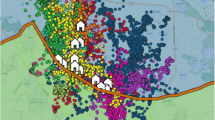Buteo regalis
), northern harriers (Circus cyaneus), burrowing owls (Athene cunicularia), and short-eared owls (Asio flammeus) inside and outside a military training site in the Snake River Birds of Prey National Conservation Area, southwestern Idaho. The Orchard Training Area is used primarily for armored vehicle training and artillery firing by the Idaho Army National Guard. Relative abundance of nesting pairs inside and outside the training site was not significantly different from 1991 to 1993 but was significantly higher on the training site in 1994 (P ≤ 0.03). Nesting success varied among years but was not significantly different inside and outside the training site (P > 0.26). In 1994, short-eared owl and burrowing owl nests were significantly closer to firing ranges used early in the spring before owls laid eggs than were random points (P < 0.001). In 1993, distances from occupied burrowing owl nests to firing ranges used early in the year were similar to those from random points to the same firing ranges (P = 0.16). Military activity contributed to some nesting failures from 1992 to 1994, but some pairs nested successfully near military activity.
Similar content being viewed by others
Author information
Authors and Affiliations
Rights and permissions
About this article
Cite this article
LEHMAN, R., STEENHOF, K., KOCHERT, M. et al. Effects of Military Training Activities on Shrub-steppe Raptors in Southwestern Idaho, USA. Environmental Management 23, 409–417 (1999). https://doi.org/10.1007/s002679900196
Issue Date:
DOI: https://doi.org/10.1007/s002679900196




